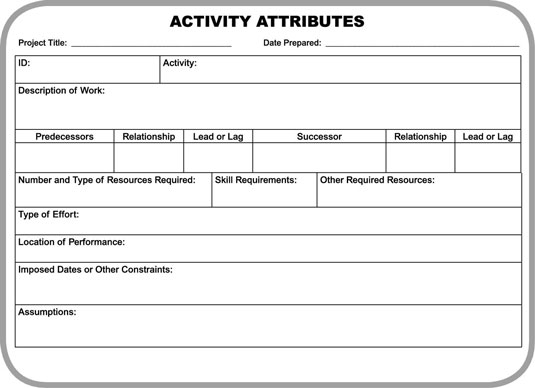After the initial planning for the schedule has been completed, you need to determine all the work that needs to be done. For PMP Certification purposes, this is referred to as Define Activities.
Define Activities. Identifying and documenting the specific actions to be performed to produce the project deliverables.
The terms activity and task can be used interchangeably in practice, literature, and the exam.
Define Activities: Inputs
The schedule management plan provides guidance on the level of detail you will use to record the project activities. To define activities, start with the scope baseline: in particular, the WBS. The WBS contains the work packages that you will decompose to determine activities. The scope statement — which gives a detailed narrative description of the project — contains assumptions and constraints that need to be considered.
You can use organizational process assets (OPAs), such as information from previous projects or templates, to help you. The organization’s information system, including the preferred software for schedule development, is an EEF that guides your approach to recording the activities.
Define Activities: Tools and Techniques
When you create your WBS, you decompose the work to create work packages. For creating the schedule, though, you decompose work packages to create schedule activities. For smaller projects, this may occur simultaneously. If you were redoing your backyard, you might identify the deck as a deliverable but then go right into the activities needed, such as set posts, cement posts, build frame, set planks, and build railing.
It is such a small project that breaking it into two steps (identifying deliverables and the activities) doesn’t make sense. You can do them at the same time. Generally, though, on larger projects, the WBS is agreed to first, and then the decomposition into activities occurs.
Activities are the actions needed to create work packages. In other words, activities are verbs. Your WBS should be noun-centric, but your activity list should be verb-centric. Look at this from the perspective of defining the activities.
| WBS Deliverable | Schedule Activities | Comment |
|---|---|---|
| 1.0 Playground equipment | 1.1 Determine equipment needs 1.2 Conduct market research 1.3 Order equipment 1.4 Equipment delivered 1.5 Install equipment |
The activities are all the actions needed to complete the deliverable. The numbering scheme from the WBS is elaborated with the schedule activities. |
Using rolling wave planning is common when identifying all the activities and developing the schedule. For long projects, though, identifying all the activities that will need to take place two years in the future isn’t feasible.
Therefore, identify only those detailed activities that you need to accomplish in a 90- to 120-day range and keep the information “in the future” at a higher level. With this approach, you can see how the process of planning and developing the schedule occurs throughout a project.
Usually, your team members identify the activities needed to complete the work packages. They have the subject matter expertise necessary to identify the steps and work needed. In some organizations, you will be able to use a schedule from a similar project to get a head start, but you will still need to have your team members review it and modify it to meet the needs for your particular project.
Define Activities: Outputs
The first output for this process is a list of activities. For a shorter project, you should build a comprehensive list. Comparatively, for a longer project, your list should have sufficient detail to build a realistic schedule.
For complex projects, it’s appropriate to extend the description of the activities by documenting activity attributes. Activity attributes can include
-
Activity identifier or code (usually an extension from the WBS numbering scheme)
-
Activity description
-
Predecessor and successor activities
-
Logical relationships
-
Leads and lags
-
Imposed dates
-
Constraints
-
Assumptions
-
Required resources and skill levels
-
Geographic location of performance
-
Type of effort
Note that at this point in time you don’t have effort or duration information. That comes later. You can always add that information to your activity attributes as a form of progressive elaboration. A list of activity attributes might be too detailed for your project. Generally, documenting activity attributes is reserved for projects that meet the following criteria:
-
Large projects with a lengthy duration
-
Complex projects with many interdependencies and stakeholders
-
Projects with much uncertainty or risk
-
Projects that include technology that’s unproven or experimental in nature
-
When contractual arrangements are in place that necessitate clear and complete definition

Tailor your project to meet your needs. If you don’t need to record activity attributes, don’t. If you need only specific information, create a form that suits your needs.
A final output of this process is a milestone list. This records all the milestones and communicates if they are mandatory (as required by a contract) or optional.
Milestone. A significant point or event in the project.

